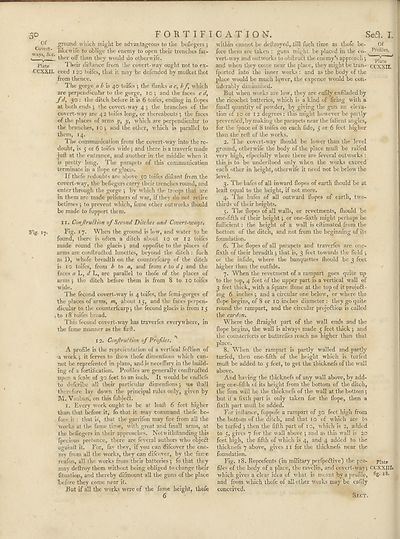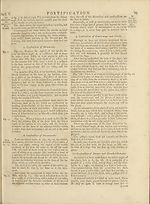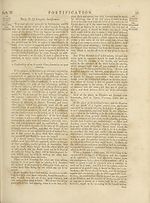Encyclopaedia Britannica, or, a Dictionary of arts, sciences, and miscellaneous literature : enlarged and improved. Illustrated with nearly six hundred engravings > Volume 9, FOR-GOT
(38) Page 30
Download files
Complete book:
Individual page:
Thumbnail gallery: Grid view | List view

30
Of "round which might be advantageous to the befiegers ;
Co'1 like wife to oblige the enemy to open their trenches far-
> _SJ ther off than they would do other wife.
Plate 1 heir diilance from the covert-way ought not to ex-
CCXXII. ceed i 20 toifes, that it may be defended by mulket ftiot
from thence.
1'he gorge « £ is 40 toifes 5 the flanks a c, bf, which
are perpendicular to the gorge, 10 j and the faces c d,
f d, 30: the ditch before it is 6 tofles, ending in flopes
at both ends j the covert-way 4 } tlie brandies of the
covert-way are 42 toifes long, or thereabouts ; the faces
of the places of arms y, y, which are perpendicular to
the branches, 10 j and the other, which is parallel to
them, 14.
The communication from the covert-way into the re¬
doubt, is 5 or 6 toifes wide*, and there is atraverfe made
jurt at the entrance, and another in the middle when it
is pretty long. The parapets of this communication
terminate in a Hope or glacis.
If thefe redoubts are above 50 toifes diffant from the
covert-way, the befiegers carry their trenches round, and
enter through the gorge ; by which the troops that are
in them are made prifoners of war, if they do not retire
betimes j to prevent which, fome other outworks fliould
be made to fupport them.
II. ConJlruRion of Second Ditches and Covert-U'ays.
Fig. 17. Fig. 17. When the ground is low, and water to be
found, there is often a ditch about 10 or 12 toifes
made round the glacis j and oppofite to the places of
arms arc conftrufted lunettes, beyond the ditch : fuch
as D, whofe breadth on the counterfcarp of the ditch
is 10 toifes, from b to a, and from c \.o d; and the
faces « L, </ L, are parallel to thofe of the places of
arms j the ditch before them is from 8 to 10 toifes
wide.
The fecond covert-way is 4 toifes, the femi-gorges of
the places of arms, /w, about 15, and the faces perpen¬
dicular to the counterfcarp j the fecond glacis is from 15
ito 18 toifes broad.
This fecond covert-way has traverfes everywhere, in
the fame manner as the fir ft.
I 2. ConftruHion of Prof/es.
A profile is the reprefentation of a vertical feftion of
•a work ; it ferves to (how thofe dimenfions which can¬
not be reprefented in plans, and is neceflary in the build¬
ing of a fortification. Profiles are generally conftrufted
upon a fcale of 30 feet to an inch. It would be endlefs
to deferibe all their particular dimenfions; we ffiall
therefore lay down the principal rules only, given by
M. Vauban, on this fubje£t.
1. Every work ought to be at leaft 6 feet higher
than that before it, fo that it may command thofe be¬
fore it : that is, that the garrifon may fire from all the
works at the fame time, with great and fmall arms, at
the befiegers in their approaches. Notwithftanding this
fpecious pretence, there are feveral authors who objedt
againft it. For, fav they, if you can difeover the ene¬
my from all the works, they can difeover, by the fan e
reafon, all the works from their batteries j fo that they
may deftroy them without being obliged to change their
fituatxon, and thereby difmount all the guns of the place
“before they come near it.
But if all the wrorks were of the fame height, thofe
Se£L I.
within cannot be deftroyed, till fuch time as thofe be- Of
fore them are taken : guns might be placed in the co- Prc^es-
vert-way and outworks to obftruct the enemy’s approach j '~J
and when they come near the place, they might be tran- CCXXIT.
fported into the inner works: and as the body of the
place would be much lower, the expence would be con-
nderably diminilhed.
But when works are low, they are eafily enfiladed by
the ricochet batteries, which is a kind of firing with a
fmall quantity of powder, by giving the gun an eleva¬
tion of 10 or 12 degrees : this might however be partly
prevented, by making the parapets near the falient angles,
for the fpace of 8 toifes on each fide, 5 or 6 feet higher
than the reft of the works.
2. The covert-way Ihould be lower than the level
ground, otherwife the body of the place muft be raifed
very high, efpecially where there are feveral outworks :
this is to be underftood only when the works exceed
each other in height, otherwife it need not be below the
level.
3. The bafesof all inrvard flopes of earth fhould be at
leaft equal to the height, if not more.
4. The bafes of all outward flopes of earth, two-
thirds of their heights.
5. The flopes of all walls, or revetments, fhould be
one-fifth of their height j or one-fixth might perhaps be
fufficient: the height of a wall is eftimated from the
bottom of the ditch, and not from the beginning of its
foundation.
6. The flopes of all parapets and traverfes are one-
fixth of their breadth j that is, 3 feet toxvards the field >
or the infide, where the banquettes fhould be 3 feet
higher than the outfide.
7. When the revetment of a rampart goes quite up
to the top, 4 feet of the upper part is a vertical wall of
3 feet thick, with a fquare ftone at the top of it projeft-
ing 6 inches ; and a circular one below, or where the
Hope begins, of 8 or 10 inches diameter : they go quite
round the rampart, and the circular projection is called
the cordon.
Where the ftraight part of the Avail ends and the
Hope begins, the wall is always made 5 feet thick j and
the counterforts or buttreiles reach no higher than that
place.
8. When the rampart is partly walled and partly
turfed, then one-fifth of the height which is turfed
muft be added to 5 feet, to get the thicknefs of the wall
above.
And having the thicknefs of any wall above, by add¬
ing one-fifth of its height from the bottom of the ditch,
the fum will be the thicknefs of the wall at the bottom;
but if a fixth part is only taken for the llope, then a
fixth part muft be added.
For inftanee, fuppofe a rampart of 30 feet high from
the bottom of the ditch, and that 10 of which are to
be turfed ; then the fifth part of 10, which is 2, added
to 5, gives 7 for the wall above ; and as this Avail is 20
feet high, the fifth of which is 4, and 4 added to the
thicknefs 7 above, gives 11 for the thicknefs near the
foundation.
Fig. 18. Reprefents (in military perfpedive) the pro- p^te
files of the body of a place, the ravelin, and covert-Avay; CCXXIIIi
which gives a clear idea of Avhat is meant by a profile, ^g- I8-
and from which thofe of all other xvorks may be eafily
conceived.
FORTIFICATION.
Sect,
Of "round which might be advantageous to the befiegers ;
Co'1 like wife to oblige the enemy to open their trenches far-
> _SJ ther off than they would do other wife.
Plate 1 heir diilance from the covert-way ought not to ex-
CCXXII. ceed i 20 toifes, that it may be defended by mulket ftiot
from thence.
1'he gorge « £ is 40 toifes 5 the flanks a c, bf, which
are perpendicular to the gorge, 10 j and the faces c d,
f d, 30: the ditch before it is 6 tofles, ending in flopes
at both ends j the covert-way 4 } tlie brandies of the
covert-way are 42 toifes long, or thereabouts ; the faces
of the places of arms y, y, which are perpendicular to
the branches, 10 j and the other, which is parallel to
them, 14.
The communication from the covert-way into the re¬
doubt, is 5 or 6 toifes wide*, and there is atraverfe made
jurt at the entrance, and another in the middle when it
is pretty long. The parapets of this communication
terminate in a Hope or glacis.
If thefe redoubts are above 50 toifes diffant from the
covert-way, the befiegers carry their trenches round, and
enter through the gorge ; by which the troops that are
in them are made prifoners of war, if they do not retire
betimes j to prevent which, fome other outworks fliould
be made to fupport them.
II. ConJlruRion of Second Ditches and Covert-U'ays.
Fig. 17. Fig. 17. When the ground is low, and water to be
found, there is often a ditch about 10 or 12 toifes
made round the glacis j and oppofite to the places of
arms arc conftrufted lunettes, beyond the ditch : fuch
as D, whofe breadth on the counterfcarp of the ditch
is 10 toifes, from b to a, and from c \.o d; and the
faces « L, </ L, are parallel to thofe of the places of
arms j the ditch before them is from 8 to 10 toifes
wide.
The fecond covert-way is 4 toifes, the femi-gorges of
the places of arms, /w, about 15, and the faces perpen¬
dicular to the counterfcarp j the fecond glacis is from 15
ito 18 toifes broad.
This fecond covert-way has traverfes everywhere, in
the fame manner as the fir ft.
I 2. ConftruHion of Prof/es.
A profile is the reprefentation of a vertical feftion of
•a work ; it ferves to (how thofe dimenfions which can¬
not be reprefented in plans, and is neceflary in the build¬
ing of a fortification. Profiles are generally conftrufted
upon a fcale of 30 feet to an inch. It would be endlefs
to deferibe all their particular dimenfions; we ffiall
therefore lay down the principal rules only, given by
M. Vauban, on this fubje£t.
1. Every work ought to be at leaft 6 feet higher
than that before it, fo that it may command thofe be¬
fore it : that is, that the garrifon may fire from all the
works at the fame time, with great and fmall arms, at
the befiegers in their approaches. Notwithftanding this
fpecious pretence, there are feveral authors who objedt
againft it. For, fav they, if you can difeover the ene¬
my from all the works, they can difeover, by the fan e
reafon, all the works from their batteries j fo that they
may deftroy them without being obliged to change their
fituatxon, and thereby difmount all the guns of the place
“before they come near it.
But if all the wrorks were of the fame height, thofe
Se£L I.
within cannot be deftroyed, till fuch time as thofe be- Of
fore them are taken : guns might be placed in the co- Prc^es-
vert-way and outworks to obftruct the enemy’s approach j '~J
and when they come near the place, they might be tran- CCXXIT.
fported into the inner works: and as the body of the
place would be much lower, the expence would be con-
nderably diminilhed.
But when works are low, they are eafily enfiladed by
the ricochet batteries, which is a kind of firing with a
fmall quantity of powder, by giving the gun an eleva¬
tion of 10 or 12 degrees : this might however be partly
prevented, by making the parapets near the falient angles,
for the fpace of 8 toifes on each fide, 5 or 6 feet higher
than the reft of the works.
2. The covert-way Ihould be lower than the level
ground, otherwife the body of the place muft be raifed
very high, efpecially where there are feveral outworks :
this is to be underftood only when the works exceed
each other in height, otherwife it need not be below the
level.
3. The bafesof all inrvard flopes of earth fhould be at
leaft equal to the height, if not more.
4. The bafes of all outward flopes of earth, two-
thirds of their heights.
5. The flopes of all walls, or revetments, fhould be
one-fifth of their height j or one-fixth might perhaps be
fufficient: the height of a wall is eftimated from the
bottom of the ditch, and not from the beginning of its
foundation.
6. The flopes of all parapets and traverfes are one-
fixth of their breadth j that is, 3 feet toxvards the field >
or the infide, where the banquettes fhould be 3 feet
higher than the outfide.
7. When the revetment of a rampart goes quite up
to the top, 4 feet of the upper part is a vertical wall of
3 feet thick, with a fquare ftone at the top of it projeft-
ing 6 inches ; and a circular one below, or where the
Hope begins, of 8 or 10 inches diameter : they go quite
round the rampart, and the circular projection is called
the cordon.
Where the ftraight part of the Avail ends and the
Hope begins, the wall is always made 5 feet thick j and
the counterforts or buttreiles reach no higher than that
place.
8. When the rampart is partly walled and partly
turfed, then one-fifth of the height which is turfed
muft be added to 5 feet, to get the thicknefs of the wall
above.
And having the thicknefs of any wall above, by add¬
ing one-fifth of its height from the bottom of the ditch,
the fum will be the thicknefs of the wall at the bottom;
but if a fixth part is only taken for the llope, then a
fixth part muft be added.
For inftanee, fuppofe a rampart of 30 feet high from
the bottom of the ditch, and that 10 of which are to
be turfed ; then the fifth part of 10, which is 2, added
to 5, gives 7 for the wall above ; and as this Avail is 20
feet high, the fifth of which is 4, and 4 added to the
thicknefs 7 above, gives 11 for the thicknefs near the
foundation.
Fig. 18. Reprefents (in military perfpedive) the pro- p^te
files of the body of a place, the ravelin, and covert-Avay; CCXXIIIi
which gives a clear idea of Avhat is meant by a profile, ^g- I8-
and from which thofe of all other xvorks may be eafily
conceived.
FORTIFICATION.
Sect,
Set display mode to:
![]() Universal Viewer |
Universal Viewer | ![]() Mirador |
Large image | Transcription
Mirador |
Large image | Transcription
Images and transcriptions on this page, including medium image downloads, may be used under the Creative Commons Attribution 4.0 International Licence unless otherwise stated. ![]()
| Permanent URL | https://digital.nls.uk/193224251 |
|---|
| Attribution and copyright: |
|
|---|
| Description | Ten editions of 'Encyclopaedia Britannica', issued from 1768-1903, in 231 volumes. Originally issued in 100 weekly parts (3 volumes) between 1768 and 1771 by publishers: Colin Macfarquhar and Andrew Bell (Edinburgh); editor: William Smellie: engraver: Andrew Bell. Expanded editions in the 19th century featured more volumes and contributions from leading experts in their fields. Managed and published in Edinburgh up to the 9th edition (25 volumes, from 1875-1889); the 10th edition (1902-1903) re-issued the 9th edition, with 11 supplementary volumes. |
|---|---|
| Additional NLS resources: |
|

